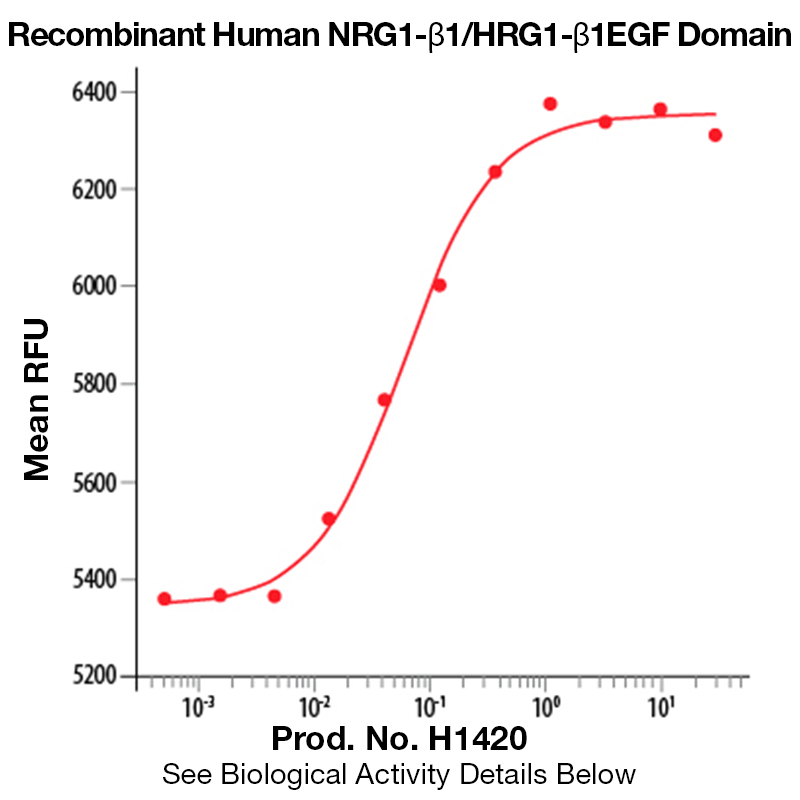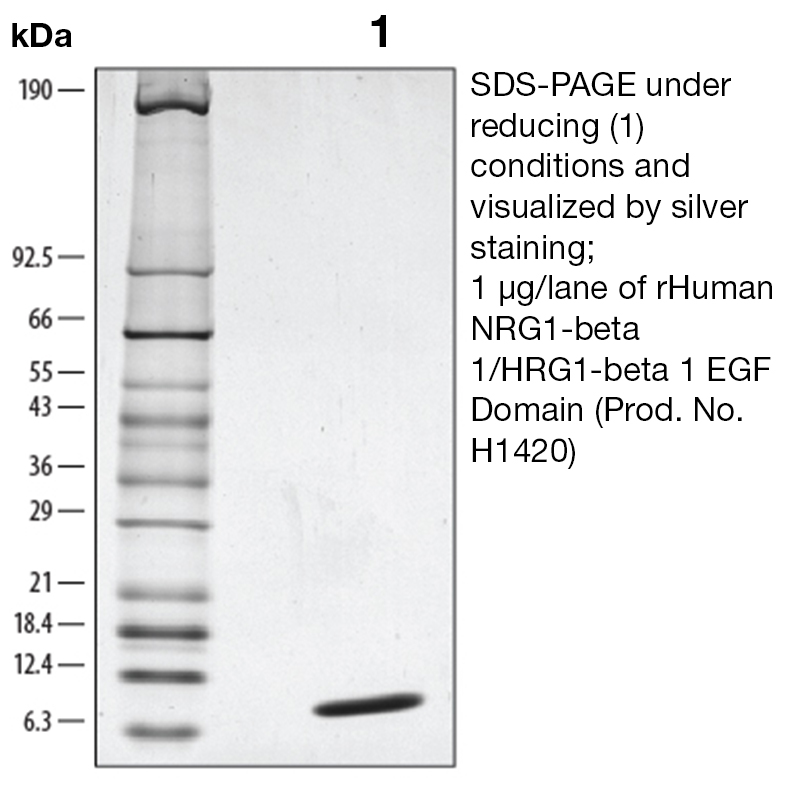Recombinant Human Heregulin-β1 (HRG1-β EGF Domain)
Recombinant Human Heregulin-β1 (HRG1-β EGF Domain)
Product No.: H1420
- -
- -
Alternate Names Heregulin 1-β1, Neuregulin1-β1 [NRG-β1], HRG, Breast Cancer Cell Differentiation Factor p45, Acetylcholine Receptor Inducing Activity [ARIA], Glial Factor, Neu Differentiation Factor Product Type Recombinant Protein Expression Host E. coli Cells Species Human |
Data
- -
- -
BackgroundNeuregulin/Heregulin is a family of related growth factors that are differentially spliced variants of four genes: NRG1, NRG2, NRG3 and NRG4. The longest forms of NRG contains several different modular domains and tissue-specific splicing results in many NRG isoforms containing different sets of these domains. Alternative splicing produces two types of EGF domain, designated a and b. HRG-Beta1 contains an Ig domain and an EGF domain necessary for direct binding to receptor tyrosine kinases erbB-3 and erbB-4. HRG-Beta1 binding causes erbB-3 and erbB-4 to dimerize with erbB-2 (Her2/neu) and thereby regulates the phosphorylation of erbB-2 tyrosines. HRG-Beta1 stimulates proliferation and motility of breast cancer cells and plays a role in wound healing by stimulating epidermal migration and differentiation of epidermal cells and by stimulating the expression of integrins in the epidermis. Protein DetailsPurity >97% by SDS-PAGE and analyzed by silver stain. Endotoxin Level <0.01 EU/µg as determined by the LAL method Biological Activity The biological activity of Human HRG-Beta1 was determined by its ability to stimulate the proliferation of human MCF-7 cells grown under serum-free conditions.<sup>1</sup> The expected ED<sub>50</sub> for this effect is typically 0.5 - 2 ng/ml. Protein Accession No. Amino Acid Sequence tshlv kcaekektfc vnggecfmvk dlsnpsrylc kcpneftgdr cqnyvmasfy khlgiefmea eelyqk N-terminal Sequence Analysis Thr176 State of Matter Lyophilized Predicted Molecular Mass The predicted molecular weight of Recombinant Human HRG1-Beta1 is Mr 8 kDa. Additionally, the actual molecular weight as observed by migration on SDS-PAGE is Mr 8 kDa (reducing conditons). Predicted Molecular Mass 8 Formulation This recombinant protein was lyophilized from a 0.2 μm filtered solution in 35% acetonitrile (CH3CN) and 0.1% trifluoroacetic acid (TFA). Storage and Stability This lyophilized protein is stable for six to twelve months when stored desiccated at -20°C to -70°C. After aseptic reconstitution, this protein may be stored at 2°C to 8°C for one month or at -20°C to -70°C in a manual defrost freezer. Avoid Repeated Freeze Thaw Cycles. See Product Insert for exact lot specific storage instructions. Country of Origin USA Shipping Next Day Ambient NCBI Gene Bank References & Citations1. Karey, KP. et al. (1988) Cancer Research 48:4083. Certificate of AnalysisIMPORTANT Use lot specific datasheet for all technical information pertaining to this recombinant protein. |
Related Products
- -
- -
Prod No. | Description |
|---|---|
N195 | |
H1420 | |
N188 |
 Products are for research use only. Not for use in diagnostic or therapeutic procedures.
Products are for research use only. Not for use in diagnostic or therapeutic procedures.




